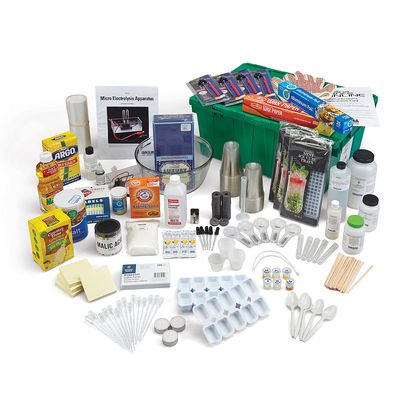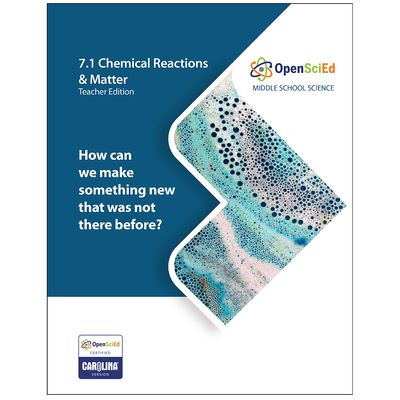Description
For additional program information and pricing, complete this form or contact your contact your sales representative.
Grades 6–8. In Unit 7.1 Chemical Reactions and Matter, Carolina Certified Version*, students work to answer the Unit Driving Question: "How can we make something new that was not there before?"
This unit on chemical reactions and matter transformations begins as students consider what happens to a bath bomb when it is added to water. They develop a model, at a scale smaller than they can see, to try to explain what they think happened to the matter that was in the bath bomb and what caused the gas bubbles to appear. This and related phenomena (where adding a solid to water resulted in gas bubbles appearing) lead to a broader set of students' questions around: How can we make something new that was not there before? Students analyze data about the bath bomb, including what happens to the amount of matter in the bath bomb and water before, during, and after gas bubbles appear; and the properties of the substances that make up the bath bomb, the water, and the gas that is produced. Students develop models to account for how new types of particles can appear from old particles. They compare their models to historical models developed by Dalton and other scientists, and they conduct investigations on water to determine if it has undergone a physical change or a chemical reaction. Finally, students revisit their initial models and explanations of the bath bomb to explain what substances could have been produced in the chemical reaction and why the mass of the matter in the system wouldn't change when this happens. They also conduct property tests that could be done to determine whether a particular substance was produced or not.
At two points during the unit, students apply what they have figured out about chemical reactions to explain related phenomena (Elephant's Toothpaste and the crumbling of the marble surface of the Taj Mahal).
Through these investigations, students:
- Plan and carry out investigations and analyze data to determine whether the matter that was in the gas bubbles produced was already part of the matter that was there beforehand.
- Analyze data to determine the properties (density, melting point, boiling point, solubility, flammability) of substances and use these properties to argue from evidence which candidate substances the gas in the bubbles from the bath bomb could be made of.
- Develop and use models to describe the atomic composition of simple molecules and extended structures.
- Analyze and interpret data on the properties of a substance (water) before and after energy is added to the substance and use these to argue from evidence for whether a chemical reaction has occurred.
- Construct an explanation to describe why the total number of atoms does not change in a chemical reaction and thus mass is conserved.
- Construct an explanation to describe possible products in a chemical reaction from a set of known reactants by considering that the type of atoms in the chemical reactions should not change.
This 1-Class Unit Kit comes with basic teacher access to instructional materials on Carolinascienceonline.com and the materials needed for a teacher to teach 1 class of 32 students per day.
Building Toward NGSS Performance Expectations
- MS-PS1-1: Develop models to describe the atomic composition of simple molecules and extended structures.
- MS-PS1-2: Analyze and interpret data on the properties of substances before and after the substances interact to determine if a chemical reaction has occurred.
- MS-PS1-5: Develop and use a model to describe how the total number of atoms does not change in a chemical reaction and thus mass is conserved.
- MS-LS1-8: Gather and synthesize information that sensory receptors respond to stimuli by sending messages to the brain for immediate behavior or storage as memories.
Science and Engineering Practices
- Developing and Using Models
- Planning and Carrying Out Investigations
- Analyzing and Interpreting Data
- Constructing Explanations and Designing Solutions
- Engaging in Argument from Evidence
Focal Disciplinary Core Ideas
- PS1.A
- PS1.B
- LS1.D
Focal Crosscutting Concepts:
- Patterns
- Scale, Proportion, and Quantity
- Energy and Matter
*All enhancements to materials and instruction for this Carolina Certified Version of the unit are approved by OpenSciEd to preserve the integrity of the storyline and the instructional model.
Specifications
- Shipping Information or Purchase Restrictions
-
- Contact us for program details and pricing. Call 800.334.5551. Limited Qty: Flammable Liquid - This product is/contains a limited quantity of a DOT regulated hazardous material. This item will not incur a hazmat fee when shipped by ground. Orders shipping to HI and AK are subject to review and may incur additional shipping charges.
- What’s Included:
-
- Unit Technology Pack (basic digital access to teacher's guide and all instructional resources for the teacher)
- Bowl, Glass
- Cups, Plastic, 10 oz
- Droppers, Medicine, Glass
- Graduated Cylinder, 10 mL
- Hot Mitts
- Ice Cube Trays, Mini
- Magnets, Ceramic Disc
- Magnifiers, Plastic, Small
- Micro Electrolysis Apparatus
- Test Tubes, Plastic, 15 mL
- Thermometers
- Alcohol, Rubbing
- Aluminum Foil
- Bags, Resealable, Plastic, 1 qt
- Baking Soda
- Bath Bombs
- Battery, Alkaline, 9 V
- Calcium Carbonate, Powder
- Candles, Tea
- Citric Acid
- Coconut Oil
- Coffee Stirrers, Wooden
- Corn Oil
- Cornstarch
- Cups, Plastic, 1 oz
- Glycerin
- Lemonade Mix
- Lemonade Mix, Sugar-Free
- Magnesium Sulfate (Epsom salts)
- Malic Acid
- Note Cards, Ruled
- Note Pads, Self-Adhesive, Medium
- Paper, Waxed
- Pipettes, Disposable Plastic, 3 mL
- Salt
- Scent Cups
- Spoons, Plastic
- Sticker Dots
- Sugar
- Toothpicks
- Trays, Lab, 10-Section
expand to see full list - Needed But Not Included:
-
- 1 Hot Plate
- 10 Digital Scales
- 4 Beakers, Plastic, 500-600 mL
- 16 Graduated Cylinders, 100 mL
- 1 Marker, Highlighting
- 8 Markers, Color
- 8 Markers, Permanent, Black
- 1 Matches or Lighter
- 1 Olive Oil, 32 oz
- 6 Paper Towels
- 2 Paper, Chart
- Gloves
- 32 Safety Goggles
- 16 Scissors
- 20 Soda Bottles, 16.9 or 20 oz, with Cap, Empty
- 8 Tape, Transparent
- 2 Water, Distilled, 1 gal
expand to see full list - Return Policy:
-
If for any reason you are not satisfied with this item, it is eligible for a return, exchange, refund, or credit up to 180 days from date of purchase. Restrictions may apply. Returns & Exchanges Policy.

